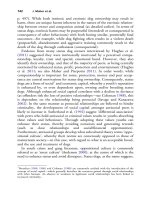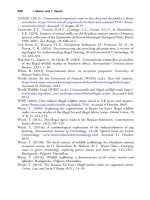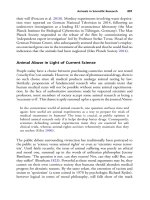The palgrave international handbook of a 105
Bạn đang xem bản rút gọn của tài liệu. Xem và tải ngay bản đầy đủ của tài liệu tại đây (36.73 KB, 1 trang )
Animal Neglect
95
Schaffner (2011) explains that a Pennsylvania law which limited owners to
no more than five dogs or cats was successfully challenged by a woman cited
for having 25 cats on the grounds that the limitation was arbitrary and
unreasonable and the restriction violated due process rights (contrary to the
14th Amendment of the US Constitution). The matter was referred for trial
and the Court was invited to consider the presumption that public health or
safety was threatened by the mere presence of a large number of animals or
whether the residence constituted a threat. In contrast a Minnesota court
concluded that an ordinance which limited households to two dogs was not
unreasonable and thus was constitutional. In this case, the burden of proof
was held to be on the owner to demonstrate that limiting the number of dogs
‘would not promote public well-being by reducing noise and odor’
(Schaffner 2011, pp. 120–121). Nurse and Ryland (2013, p. 65) identify
that, under UK law, for the keeping of animals to become actionable as a
nuisance some ‘extraordinary, non-natural or unreasonable action’ is
required (see Peech v Best [1931] 1 KB 1, 14). However, nuisances involving
animals are not uncommon and the keeping of an excessive number of cats or
dogs, for example, can give rise to nuisance complaints concerning odour,
noise or relating to health concerns. The intent of the legislation is to
improve human health and to protect humans from nuisances affecting
peaceful enjoyment of their property (although in places the Act refers to
wider harm caused to ‘living organisms’). Analysing UK case law Nurse and
Ryland (2013, pp. 65–66.) identified that in cases of insufficient care caused
by neglect, a local authority might use Section 79(1)(f) of the EPA 1990 to
serve a specific notice requiring works to be carried out to improve the
conditions under which animals are kept. In particular where the living
conditions of non-human animals, including the number of animals produces problems such as excessive smell, noise or flies, action might be taken,
although overcrowding by itself is not subject to action via this provision.
However, where overcrowding causes the nuisance, for example, somebody
keeps too many non-human companions and the number combined with the
conditions causes a nuisance, then a local authority could impose restrictions
on the number of animals kept thus addressing neglect issues.
The ALDF argues that comprehensive criminal prohibitions which
include objective standards of care with well-defined neglect-related terms
are essential to addressing neglect offences.5 However, they also identify
5
Such provisions exist in some animal welfare laws but the ALDF observation also amounts to a
recommendation that there is a need for wider use of such provisions.









